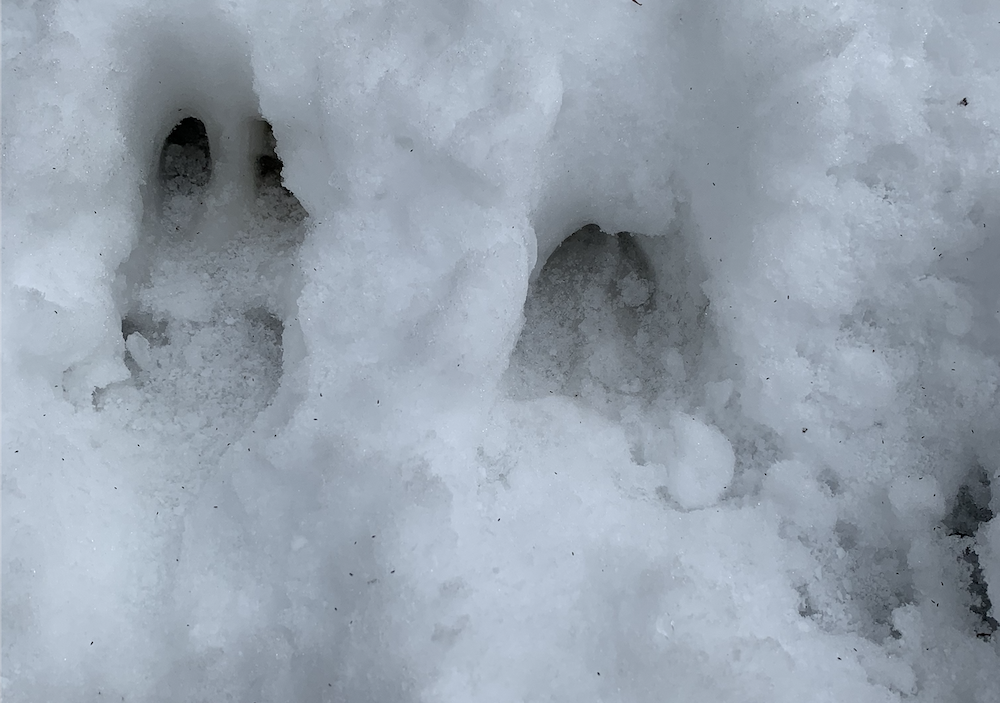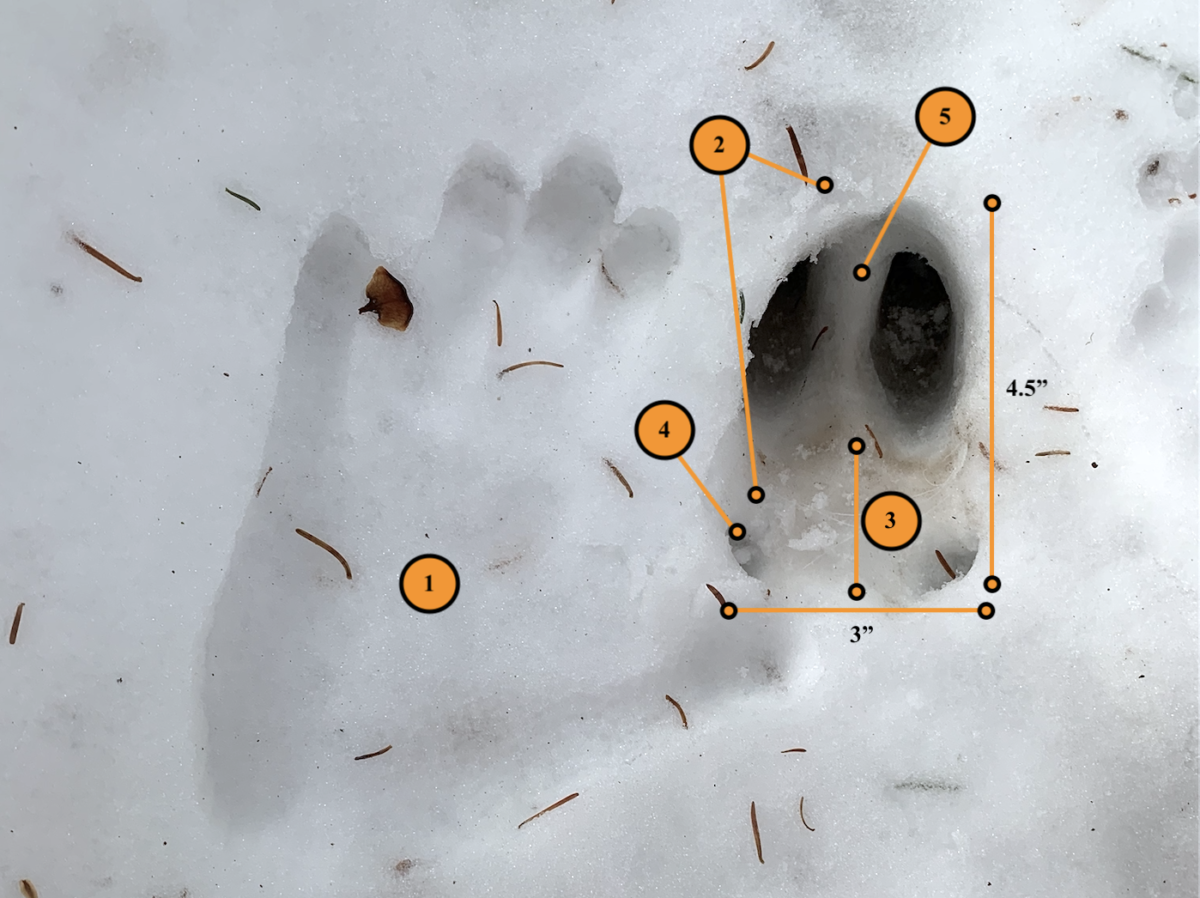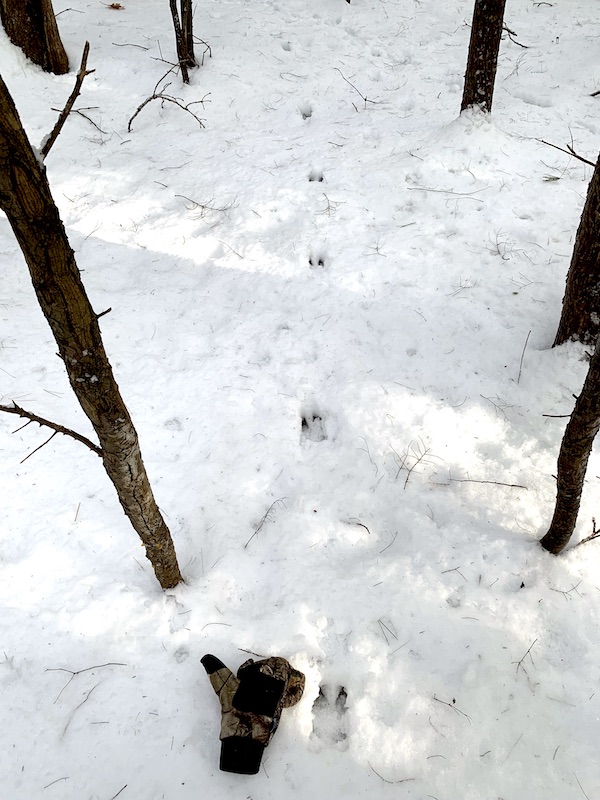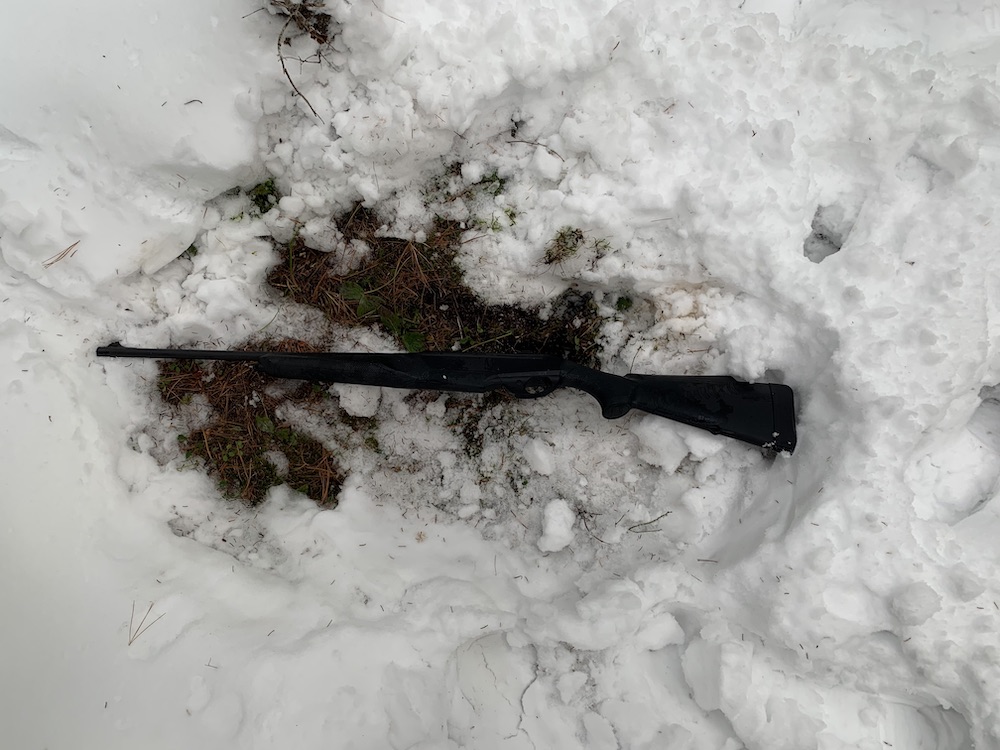Last Updated on January 1, 2022 by Jason Tome
In this post, you’ll learn how to track big woods bucks in snow. Being able to judge and read whether a track was made by a big buck, small buck, doe, or fawn is key to your success. Otherwise, you might walk miles, just to realize you’ve been tracking a small buck or doe! It may seem difficult at first but with the information in this post and a little practice, you’ll learn how to track big bucks in snow in no time.
Although the size of the track itself is a good indicator of the size of the deer you’re following, it’s not always best to rely on just the size. There are also other indicators (behavioral and physical) that will either support or disprove your initial observations of a big buck track. Judging and reading a big buck track consists of a handful of subtle and not so subtle clues that when pieced together start to unravel the bigger picture. I will be going to all of these ways in this post.
Table of Contents
Tracking Big Bucks In Snow (Start Here)
If you haven’t read the other posts in this tracking series I suggest you do before you continue on:
- Gear and Preparations For Tracking Big Bucks In Snow
- Where To Find Big Buck Tracks – Tracking In Snow
When I first started tracking big woods bucks in snow I thought it was going to be easy to tell the difference between a big buck’s track and other deer. I thought this because I had a lot of experience with tracks in non-snowy conditions and could easily judge a big track in the sand, mud, bare ground, and even in a few inches of snow. However, when I started tracking big bucks in deeper snow in northern Maine and New Hampshire, the skills I thought I had were greatly challenged by snow depth and snow consistency. In this post, I describe the factors I consider when judging a big buck’s track in snow.
Temperature & Weather
Temperature plays a huge role in determining how big a track looks. If the temperature is warm and the track is melting, then the track may look a lot bigger than when it was fresh.
This is also true during rainy days where the track is melting fast. It’s important to keep a log of the temperatures and weather in the back of your mind. Or even write them down each day in a notebook/ This will help to understand the influences weather has had on tracks. I often take screenshots of previous days’ weather and the predictions for the current day. This way I know what to expect the tracks should look like.
What I have found helps me determine if a track would be considered big or not based on the temperature and weather influences, is to focus in my mind on what a perfectly preserved, fresh track would look like with no outside influences. Then in my mind, still thinking of the perfectly preserved track, I do my best to run a ‘time-lapse’. Based on past and present temperatures and weather conditions, then visualize what the track would look at the present moment. I compare what I’m picturing in my mind to the track in order to determine if I think it’s a track worth following. I’ve even kept pictures on my phone so that I can refer back to how certain tracks looked during certain conditions.
How To Differentiate Tracks In Snow (Big Buck vs Small Buck vs Doe)
Track Size
Although the best way to become familiar with how to differentiate tracks is by looking at a lot of tracks in a range of conditions, there are some key factors that can help you make the right choice. One factor is a big buck will almost always have a bigger track than other deer.

There are a lot of influences that can alter your perception and judgment of a big track, nevertheless, the first step is to start looking for big tracks. Once you’ve found what you think is a big track, you can get more precise on your reading of the track.
Track Measurements
Common quick-measurements you can use in the woods to tell if a track was made by a big buck are if in the width of the track is roughly the length of a 30-06 cartridge or a ‘four-finger track’. This is roughly a 3-inch track in width, anything bigger is a bonus. The length is not as good of a predictor of weight as width, but most big buck tracks are around 4.5-inches from tip to dewclaws.
After you’ve had experience looking at many tracks you’ll build a library of past tracks in your subconscious mind that will help you make quicker analyses in the future. In other words, you’ll get an eye for it. You’ll notice the track is in the 10% club. Meaning that out of all the tracks you’ve seen, only 10% of deer make tracks that big so you know it’s a heavy deer. Indicator 1 in the photo below is showing my handprint in current conditions to compare to the buck’s track. Indicator 2 is showing the snow debris left behind after the buck made the track. This snow is soft and melting, but the debris has not melted. This is a fresh track.

Dew Claws
All deer do have dewclaws, which will show in snow. Just because you see dewclaws does not mean it’s a buck. That being said, big tracks have more defined dewclaws. Dewclaws on big bucks are set back further than most other deer (indicator 3) and are at roughly a 45º angle (Indicator 4).
It is important to realize that big bucks can have smaller tracks. It’s just that the odds are in your favor if you take a big track rather than a medium-sized track. Just know that a medium-sized track might have been made by a big buck. If you see a smaller than usual track, but other indications are showing (see below), the track might still be worth taking so don’t rule it out.
Splayed-Toe Tracks
In addition to the size and dewclaws, a big buck will have splayed out toes from his weight (Indicator 5). This means that his toes will be spread apart further than other deer.
Deer Track Stride Length
The next thing to look at is stride. The stride is an indicator of the overall length of deer. The longer the deer the more it weighs. A deer might have a smaller than top 10% track, but I’ll consider taking it if it has a good stride. A couple of feet between tracks is a good indication of a long buck. Just be aware that bucks are always changing their strides in relation to their attitudes. So it is best to follow the track for a short distance to figure out the track’s baseline stride (see baseline section below). Once you’ve tracked a few deer, you’ll start to notice which tracks have obviously longer strides than others.

Track Gait/Swagger
Next look at the swagger or gait. This is how much the buck sways when walking. If the bucks toes are pointing abnormally outward and the length of the gait is around 8-12” you’ve got a wide chested buck, indicating girth, another indicator of weight. Picture a fat man waddling through the woods vs a skinny teenager.
Toe-Draggers
Another indicator to key in on is how much the buck drags his feet. Big bucks typically drag their feet more than other deer because they are older, bigger, and don’t have the same mobility as they used to. If you see a track making big cross-country ski trails, there’s a good chance it’s a good buck.

Antler Size Indicators
If the track you’re looking at meets some or all of these criteria (more the better), you know you’re on a big buck’s track. If you want to get even pickier you can observe antler size while tracking. By looking at where the buck walks you can determine how wide a buck’s rack is. Of course, there are more obvious ways to tell like rubbing on trees, but there are also more subtle ways. These ways include; size of gaps between trees he avoids, broken branches between trees he walks through, tine marks on blowdowns he crawls under, tine marks when feeding on the ground, and tine marks if he lays his head down when bedded.
Bed Size
Another way to gauge how big a buck is other than his track is by looking at the size of his bed. You’ll have to take into consideration how long he was laying in his bed because the longer he lays, the bigger the bed will look. You will almost always see the tarsal glands of the buck in the bed. Sometimes you can see urine spots. The position of the urine in the bed will also tell you if you’ve been tracking a buck or a doe. Buck urine spots will be closer to the center of the bed.

Buck Attitude And Demeanor vs Does
Does and bucks have different attitudes. If you’re on a questionable track, you can often get a feel for if the track was made by a buck or a doe by following a track for some distance. During the rut, bucks have one thing on their mind and it shows. You can often see their excitement by strides being often longer than their baseline (see paragraph below), and even leaping for short distances to speed up travel.
Does, on the other hand, have less purpose in their steps, and they don’t travel very far. They have a much smaller home range and will often do small circles in an area if tracked for any distance.
Deep Snow & Powdery Snow
This is all well and good, but what if the snow is sugary, deep or both? Identifying tracks in this type of snow can be frustrating. I know it was for me, and even still is at times because you can’t see the track. If you can’t see the track, then how do you tell if you’re ever on a buck or not? The trick here is to use all of the tools listed below and mix and match as many of those as you can. You will probably need to follow the track for a longer period of time to get a good read on the track. You don’t always need to see the track to know it’s a buck. But it does make the process more difficult.
What Is A Track’s Baseline?
I define baseline as; the tracks an individual buck makes when he is calm and predictable. I always try to find a buck’s baseline to get the best judgment of a track. Otherwise, there are factors that can fool you into thinking a buck is bigger or smaller than it really is.
It’s important to visualize what that buck’s behavior was like at the exact moment he made the tracks you’re observing. For example, if the deer is running the track is going to look splayed and bigger. It can be easy to mistake a doe for a buck in these instances. Additionally, if a deer is excited because he smells a doe or startled because of a limb cracking he may start walking at a fast pace, making his track look like it has a long stride when in reality it isn’t when the deer is calm and at its regular pace.
How To Determine Track Baseline
Follow the track for a few hundred yards or until you feel like you’ve got a good feel for the track. What is the deer doing? Is he marching across the hardwoods on a beeline looking for does? If so, his stride may look bigger than baseline. Or is he moseying around a little bit? Is he with a doe or by himself? zigzagging? nipping buds? All of these will influence how you perceive the size of the buck who made the track.
Take note of what you’re seeing most often. Is the track usually very long, but sometimes is short? Does he have a gait, but sometimes it doesn’t look like he has a gait at all? Does his track look big but then other times it looks smaller than what you thought?
If you had a clone copy of a specific buck, your perception of size in each of these different scenarios listed above. A monster buck might look like he has a small gait if he’s not in any rush to go anywhere. Take into consideration what that particular deer is doing and extrapolate your observations in order to interpret the size of the buck. Otherwise, you could follow the same deer all day and think he’s a monster buck at some points and the smallest buck you’ve ever followed at other times.
What I find helpful for people is to take the average of what you are seeing and that’s generally a good representation of the buck’s size. If 75% of the time it looks like a big buck than it probably is. If only 25% of the time, then perhaps you should find another track. Just make sure you are taking baseline into consideration.
Is The Buck Track Worth Following?
Time Of Year
Not every big buck track you find is worth following. The time of year will help you decide if a track is worth following. If it’s early season, or late season your odds of catching up with an older track are greater, as bucks usually aren’t going very far. However, if you find a big track that looks older, and it’s in the middle of the rut, I would think twice about following that buck.
Rested Or Tired?
You can get an idea of a buck’s energy levels by looking at where the tracks are headed. If the tracks are going from the lowlands up towards a mountain than that buck is probably tired and is going to bed down on top. The same can be said for a buck entering a big swamp, especially a cedar swamp. An even better indicator that he will be bedded in these areas is if you notice some feeding sign along the way. Tired bucks are bucks you can catch during the rut.
If you flip this scenario around, and the bucks are leaving these areas, or you’ve come across beds during the rut then he may be ready to travel a long distance. You’ll have to judge this by following the track for a while.
These are just suggestions to keep in mind. Of course, anything can happen on the track. A well-rested buck may get caught up with a doe. In that case, you could kill a rested buck. This is the name of the game. Sometimes, even on fresh track you may never catch up to a buck during the rut. All you can do is put the odds in your favor as much as possible.
Conclusion
A big buck may have some or all of the characteristics described above. Of course, the more indicators a buck is showing, the better chance you’re on a big buck’s track. Puzzle together the characteristics the specific track is displaying using the criteria above and you’ll be well on your way to become an expert at judging and reading big woods buck tracks in snow. After you’ve been on a few tracks, you’ll quickly learn how to track big woods bucks in snow and differentiate between big buck tracks and other deer tracks.
